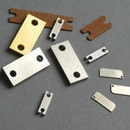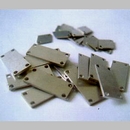Copper molybdenum heat sinks



Copper molybdenum heat sinks introduction
Copper molybdenum composites to be used extensively in thermal mounting plates, chip carriers, flanges, and frames for high-powered electronic devices. With the thermal advantages of copper with the very low expansion characteristics of molybdenum, molybdenum copper has properties similar to those of silicone carbide, aluminum oxide, and beryllium oxide. The thermal conductivity and low expansion also make molybdenum copper alloy an excellent choice even for extremely dense circuits.
Copper molybdenum high performance composites are fabricated from carefully controlled porous Molybdenum that is vacuum infiltrated with molten copper. This results in a MoCu composite that has high conductivity and a matched low thermal expansion for heat sinks.
The data of copper molybdenum heat sinks
|
Ingredients Name |
CAS Number |
% Weight |
| Molybdenum | 7439-98-7 | 50-85 |
| Copper | 7440-50-8 | 15-50 |
|
Composition |
Mo 85% |
Mo 70% |
Mo 50% |
| Density (g/cm3) |
10.0 | 9.6 | 9.5 |
| Coefficient of Thermal Expansion (10-6/K) |
6.3 | 7.5 | 9.8 |
| Thermal Conductivity (W/mK) |
160 | 190 | 245 |
| Specific Heat Capacity (J/kgK) |
275 | 300 | 320 |
| Young’s Modulus (Gpa) |
275 | 220 | 170 |
| Specific Electrical Resistance (uΩm) |
0.044 | 0.035 | 0.027 |
| Vickers Hardness (HV10) |
235 | 175 | 145 |
Related Links
Copper Tungsten Heat Sinks
Property Data Sheet of Copper Tungsten Heat Sinks (PDF)















